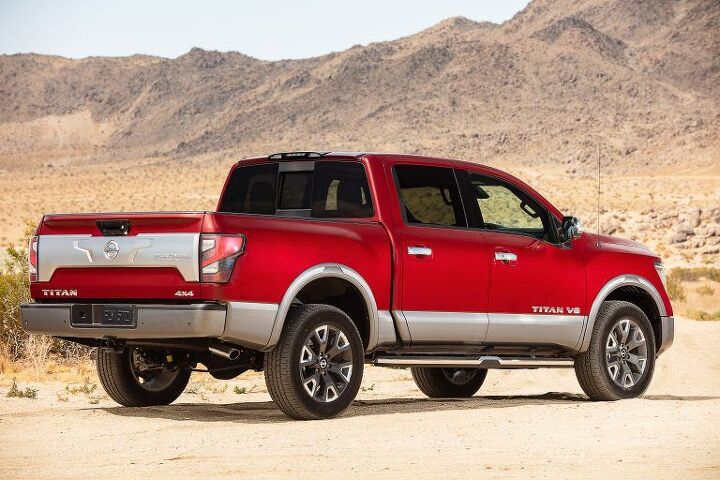2020 Nissan Titan Fuel Economy Figures Emerge

What can a nine-speed automatic do for a full-size pickup that once carried a seven-speed unit and a reputation for guzzling fuel at a prodigious rate?
That’s a question answered not by the EPA, which hasn’t gotten around to posting updated MPG figures for the refreshed 2020 pickup, but by its counterparts north of the border. Natural Resources Canada has the new figures on file, but you’re out of luck if you’re only interested in rear-wheel drive Titan models. For 2020, Canadians aren’t allowed to have those.
Forgive the inclusion of metric figures on these predominately American pages.
If you’ll recall, the EPA rated the 2019 Titan (not Titan XD) at 15 mpg city, 21 mpg highway, and 18 mpg combined when equipped with four-wheel drive and Nissan’s lone 5.6-liter gasoline V8 engine (retuned to make 400 horsepower for the current model year). Canadian ratings amounted to the same. It’s worth noting that 2WD Titans earned the exact same rating, so that’s something to remember as we plow forward.
For 2020, the Titan ditches its seven-speed in favor of a nine-speed automatic with a larger final drive ratio aimed at improved pulling power across the range. This implies not much in the way of increased fuel economy.
And that’s what we see here. Natural Resources Canada rates the 2020 Titan 4X4 at 15.1l/100km in the city, 11.1 on the highway, and 13.3 combined, which translates to (just barely) 16 mpg city, 21 mpg highway, and 18 mpg combined. The only upward movement of gas mileage occurs in the city and combined fields, which creep upward by one-tenth of a liter per 100 km. For city driving, that slimmest of increases is enough to round the U.S. figure up to 16 mpg.
So, not a lot of change, but things get more exciting when considering the brawny Pro-4X variant. The 2019 model carried an EPA rating of 15 city, 20 highway, and 17 combined, which is born out in annoyingly metric Canuck calculations.
For 2020, the four-wheel drive Titan Pro-4X earns a Canadian rating that translates into 16 mpg city, 21 highway, and 18 combined. In other words, a 1 mpg increase in all fields. Not a full MPG, mind you, but an increase nonetheless.
The updated tranny hasn’t done much to improve the Titan’s thirst, especially when compared to its Detroit rivals, all three of which have light-duty diesels on offer (or, in the case of GM, on the way), downsized six-cylinders, and even a lone four-cylinder turbo. But fuel economy is just one consideration when buying a big-bucks pickup.
As one colleague likes to inform me, Titan owners often state that their fuel economy doesn’t drop in the slightest when towing, which is a perk that’s hard to shoehorn into marketing materials without calling out the unloaded truck’s thirst.
Stay tuned for a broader range of EPA figures.
[Images: Nissan]

More by Steph Willems
Latest Car Reviews
Read moreLatest Product Reviews
Read moreRecent Comments
- MaintenanceCosts Nice car if you can get it properly sorted, but the level of safety tech doesn't seem quite enough for a young driver on today's brodozer-infested highways.
- VoGhost OK. But if Subaru really wants this to sell, they'd make it as a PHEV with enough American content to get buyers $7,500 back on their federal taxes. Otherwise, this really doesn't stand out in a world of RAV4s and CR-Vs.
- VoGhost Tesla has an average of 28 days of inventory, less than half industry average.
- FreedMike Ah, Chesterfield Mall...my old teenage stomping grounds. Bummer what happened to it, that's for sure. But that's what happens when the city council approves not one, but two "premium" outlet malls right down the road to be built. That killed this mall dead.And in case anyone's interested...yes, Teslas and other EVs are very popular in that neighborhood.
- MaintenanceCosts Subarus can be durable, but they are going to demand more frequent and expensive regular maintenance than your typical Honda or Toyota. I suspect for a lot of third and fourth owners that means the economic equation favors scrapping them a bit earlier.




































Comments
Join the conversation
The part that's annoying is the x100. Why? Instead of 13.3l/100km, what's wrong with simply "0.133 lpkm"? Is it because it sounds stupid that way? I say it does either way. Or why not a translated 5.9G/100miles (17 MPG)? Or better yet, a US 0.059 GPM???
Thanks jack4x and bullnuke, most helpful in your comments. Have forwarded them to my son’s email. Yes, the truck is used everyday to tow and haul by my son or his business partner. I mean, every day. No break for weekends or days off. In the cattle business there are no days off and deliveries to the reservation of cattle and/or horses are often made on the weekends. There were times when I had to help out and make a delivery when both of them were out doing something and they needed an extra driver.